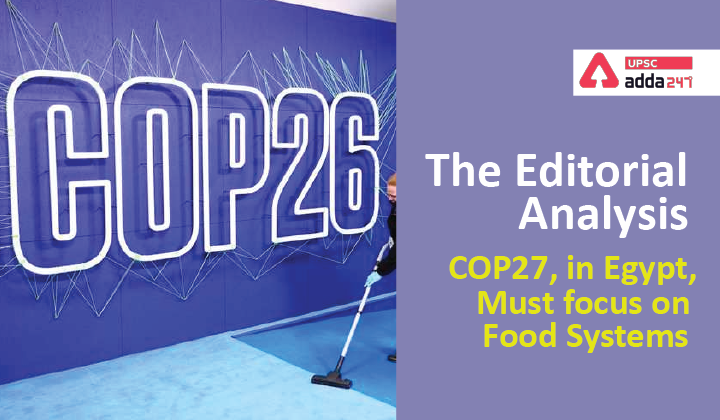Table of Contents
COP 27: Relevance
- GS 3: Food Security
COP 27: Context
- Climate change is seriously impacting the food system across the world and the next COP, COP27, must address the issue.
COP 27: Key points
- COP 26: The commitment to put forth a record-shattering U.S.$356 million to support the most vulnerable population is commendable, however, it is not enough to stay below the limit of 2°C above pre-industrial levels.
Climate crisis and hunger
- SDG 2 mentions about ending world hunger and malnutrition in all its forms by 2030. However, the agenda is facing critical issues due to various issues.
- The link between climate crisis and hunger is well-acknowledged across the world.
- Analysis by the United Nations World Food Programme (WFP) shows that a 2°C rise in average global temperature from pre-industrial levels will see around 190 million additional people in the grip of hunger.
- Intergovernmental Panel on Climate Change (IPCC) report has also stated that the climate crisis will not only impact food production and livelihoods but also threaten nutrition through multi-breadbasket failures.
- The COVID-19 pandemic has only worsened the situation as it has doubled the population under chronic hunger from 130 million to 270 million.
- Vulnerable communities like farmers, fishermen who contribute the least to the climate crisis, will continue to bear the brunt of the impacts. The absence of social protection measures such as food safety nets forces the food insecure to depend on humanitarian aid for survival.
- The top 10 most food-insecure countries contribute just 0.08% of global carbon emissions.
Adaptation is urgent
- In its outcome document, COP 26 has acknowledged that rising temperature will continue to have adverse impacts on the vulnerable people.
- There is a strong emphasis on the urgency of scaling up action and support, including finance, capacity-building, and technology transfer, to enhance adaptive capacity, strengthen resilience and reduce vulnerability to climate change.
Adaptation finance
- COP 26 observed that the contributions made to the Adaptation Fund and the Least Developed Countries Fund, represent significant progress when compared with previous efforts.
- However, current climate finance for adaptation remains insufficient to respond to worsening climate change impacts.
- There is a need for funding for developing nations, 50% for adaptation and resilience to the climate crisis. Moreover, developing countries already need $70 billion for adaptation, and that figure could more than quadruple to $300 billion a year by the end of this decade.
- In India, the WFP and the Ministry of Environment, Climate Change, and Forestry are planning to develop a best practice model on adaptation and mitigation with potential support from the Adaptation Fund.
Key areas to focus on
- Creating resilient livelihoods and food security solutions by protecting and improving the livelihood of vulnerable communities.
- The adaptation of climate-resilient food crops, such as millets, for nutritional security.
- Enabling women’s control and ownership of production processes and assets and increased value addition and local solutions.
- Promoting a resilient agriculture sector by creating sustainable opportunities, access to finance, and innovation for small-holder farmers, with climate information and preparedness.
- Building capacity and knowledge of civil society and governments for vulnerability analysis to increase food security by addressing the link between food security and climate risk.
Fixing broken food systems
- UN Food Systems Summit, held a few months before COP 26, revealed that food systems are unequal, strained, or broken as 811 million people are going to bed hungry.
- This critical issue requires reimagining the food system towards balancing growth and sustainability, mitigating climate change, ensuring healthy, safe, quality, and affordable food, with investment from governments and the private sector in supporting farmers while maintaining biodiversity, improving resilience, and offering attractive income and work environment to smallholders and youth.
Also Read:





 TSPSC Group 1 Question Paper 2024, Downl...
TSPSC Group 1 Question Paper 2024, Downl...
 TSPSC Group 1 Answer key 2024 Out, Downl...
TSPSC Group 1 Answer key 2024 Out, Downl...
 UPSC Prelims 2024 Question Paper, Downlo...
UPSC Prelims 2024 Question Paper, Downlo...





